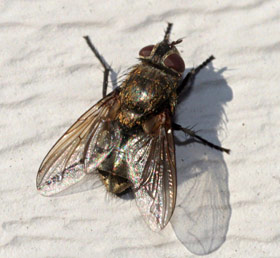Cluster Fly, Pollenia rudis

Joseph Berger, Bugwood.org.
IPM Steps to Reduce Cluster Flies
1. Sample for Pest
Confirm the presence of these pests.
Where to find it while inspecting: Cluster flies often are unseen inside a building until a sunny day brings them out of hiding inside wall voids via attics and loose trim. You will often find them in south windows. They find their way into walls and windows in fall to overwinter. Look for crevices that invite them in, and you will deter them and other overwintering pests by blocking the entry ways.
2. Proper ID
Before you act, determine what species of fly is in your building.
Size and Particulars: Cluster flies are usually larger than houseflies and have yellowish hairs on their thorax (body).
3. Learn the Pest Biology
Knowing the life cycle helps you fight fly infestations.
Life Cycle: Multiple generations per season. Only adults overwinter.
Preferred Food Sources: Earthworms and other organic matter, but not garbage.
Preferred Habitat: In winter they are looking for protective habitat such as inside walls.
4. Determine Threshold
Flies are annoying, but what is your threshold for infestation? When should you act?
Threshold: You will know if you have one stray or a larger number as they are all likely to show up at once during the winter if they have found an interior place to over winter.
5. Choose Tactics
IPM for indoor pests is always a combination of exclusion and sanitation: Try to keep them out. Don’t provide water, food and shelter if they enter your building.
Best Management Practices: Exclusion is the number one way to reduce. Caulk to close entryways in siding, windows, trim, soffits, etc. You may want to place fine mesh screening over areas where caulk is not feasible or useful (such as soffits). A vacuum cleaner is a good tool for removing live cluster flies.
Treatment Methods: An insecticide is last resort option in areas of major cluster fly invasions. In some areas away from food or human activity, specifically students, pest strips may be used. Verify what is allowed by the IPM policy in your facility. Remember that using a pest strip with an insecticide is the use of a pesticide and must be done by a certified pesticide applicator.
6. Evaluate
Was the tactic successful? Record the date pests were first noted, and the tactic you used, and its success. Use one of our RECORD KEEPING tools.
For More Information:
UMaine Extension: Cluster Flies
Remember:
When a pesticide application is necessary, all necessary and required precautions are taken to minimize risk to people and the environment and to minimize risk of pesticide resistance or pest resurgence. Pesticide use in your school may be prohibited or regulated by local policies or state and federal regulations. Risk reduction methods can include, but are not limited to, spot-treatment, the use of gel or paste bait formulations placed in inaccessible locations, injection into a crack or crevice, and other methods that reduce potential exposure.